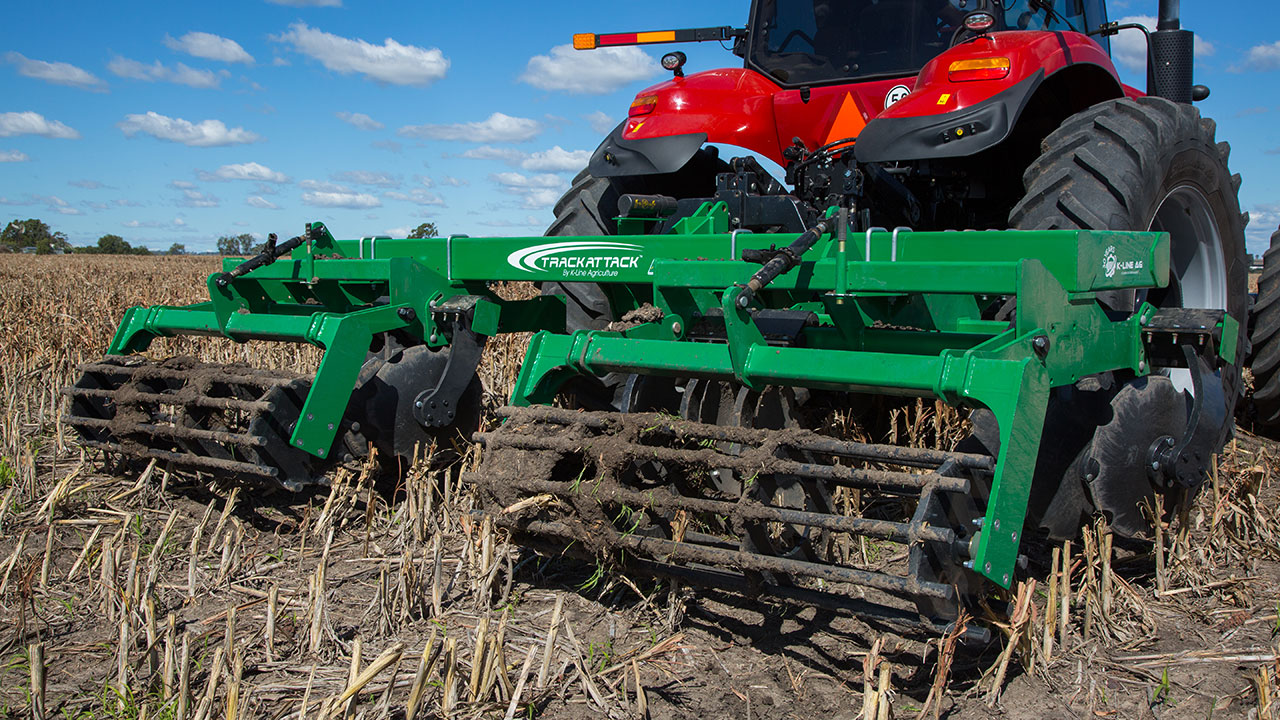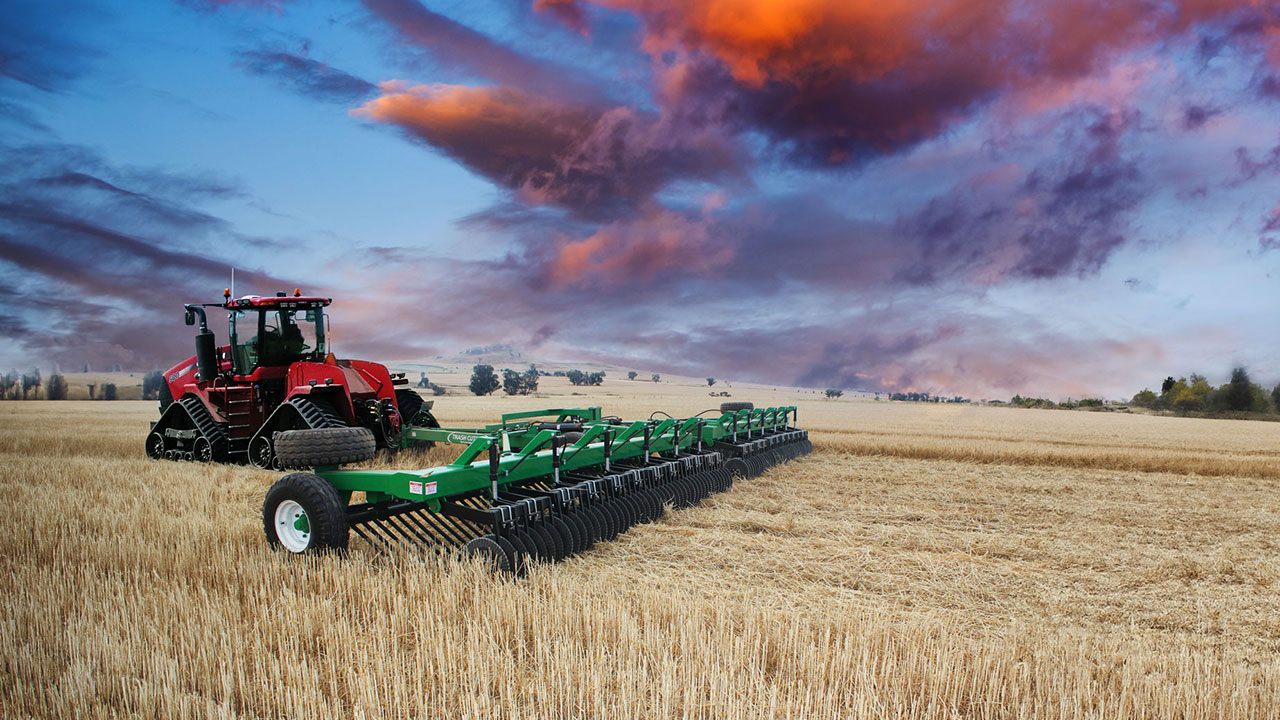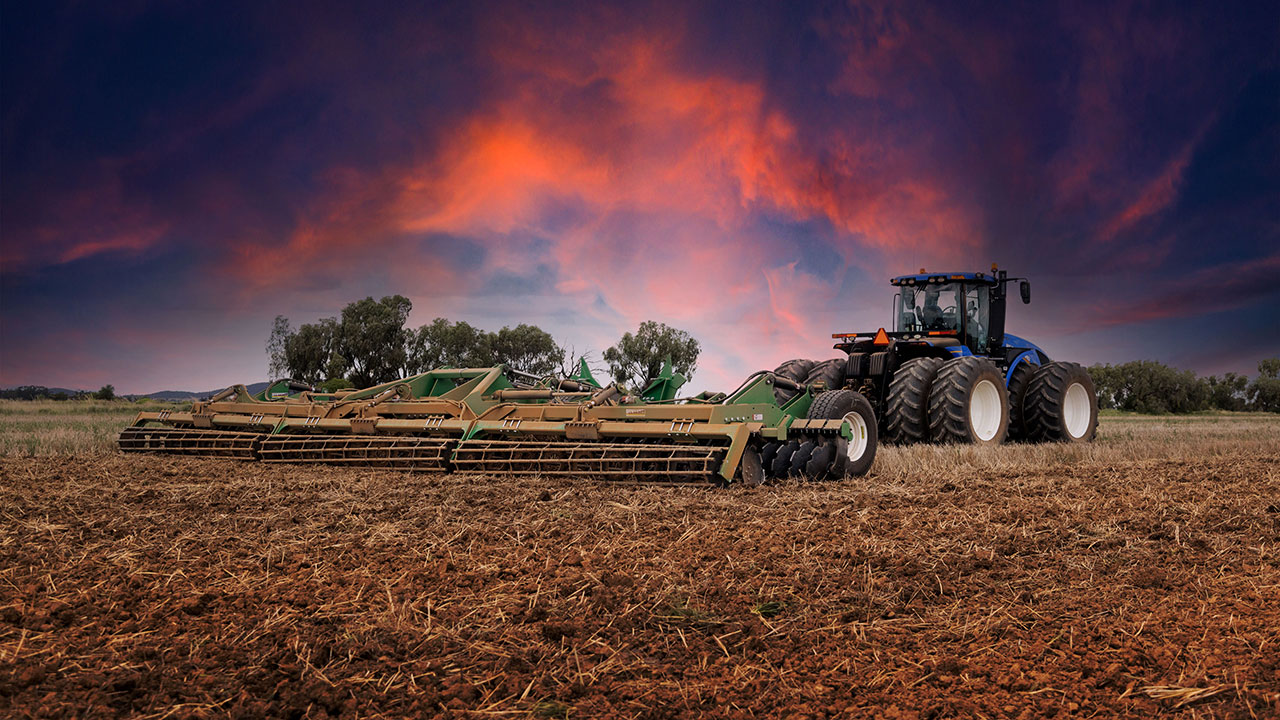Crop residue management is essential for maintaining soil health and crop productivity. Research has shown that managing crop residues can improve soil health by increasing soil organic matter, water holding capacity, and nutrient cycling (Mamo et al., 2019). In contrast, leaving crop residues on the soil surface can lead to reduced soil health by promoting erosion, weed growth, and pest and disease pressure (Staley et al., 2018).
Effective management involves incorporating crop residues into the soil. The Trashcutter® and CropCadet® machines from K-Line Ag are designed to help farmers manage residues effectively. The Trashcutter® cuts and mulches residues, while the CropCadet® cuts and chops crop residues into smaller pieces, making them easier to incorporate into the soil.
The Trashcutter®: A Heavy-Duty Solution
K-Line Ag’s Trashcutter® is a heavy-duty implement designed to cut, mulch, and spread crop residue. It features a high-speed rotating drum fitted with sharp blades to cut through tough crop residue like wheat and corn stalks. The Trashcutter® is ideal for farmers who practice conservation tillage, as it can help reduce soil erosion and improve soil structure by incorporating crop residue into the soil. Research has shown that conservation tillage can improve soil health and reduce fuel consumption (Rusinamhodzi et al., 2011).
The CropCadet®: A Unique Solution
The CropCadet® machine is another innovative tool from K-Line Ag designed to manage crop residues and prepare the soil for the next planting season. It features a series of shallow discs that are angled to create a cutting edge. The CropCadet® can be used to cut and chop crop residue into smaller pieces, making it easier to incorporate into the soil. It can also be used to prepare a seedbed for the next crop by breaking up clumps of soil and leveling the surface. By using the CropCadet® machine, farmers can improve soil structure and prepare the soil for optimal planting conditions.
Benefits of Effective Crop Residue Management
Research has shown that incorporating crop residues into the soil can improve soil health by increasing soil organic matter, water holding capacity, and nutrient cycling (Mamo et al., 2019). Soil organic matter is a key factor in soil fertility and nutrient cycling, and it improves soil structure by increasing the stability of soil aggregates and improving water infiltration (Hati et al., 2006). A study conducted in India found that incorporating crop residues into the soil improved soil physical properties, increased soil water storage, and improved crop yields (Gupta et al., 2017).
In addition to improving soil health, managing crop residues can also help reduce pest and disease pressure. Crop residues left on the soil surface can provide a habitat for pests and diseases, which can then infect the next crop. Research has shown that managing crop residues can reduce the incidence of pests and diseases (Trenkel, 2010). For example, a study conducted in the United States found that managing crop residues reduced the incidence of soybean cyst nematode, a common pest that can significantly reduce crop yields (Giesler et al., 2015).
Further benefits of effective crop residue management include reducing the need for tillage. Excessive tillage can damage soil structure and reduce soil health. By incorporating crop residues into the soil using the Trashcutter® and CropCadet® machines, farmers can reduce the need for tillage, which can save time and money while reducing fuel input costs. A study conducted in Australia found that conservation tillage, which involves managing crop residues without excessive tillage, can significantly reduce fuel consumption and greenhouse gas emissions (Rusinamhodzi et al., 2011).
Reducing the Impact of Pests and Diseases
Effective crop residue management can help reduce the impact of pests and diseases on crops. Crop residues left on the soil surface can provide a habitat for pests and diseases, which can then infect the next crop. Managing crop residues by cutting, mulching, and incorporating them into the soil can reduce the risk of pest and disease contamination. A study conducted in Australia found that the incorporation of crop residues into the soil can reduce the incidence of root diseases in wheat crops (Kirkegaard et al., 2014).
Effective crop residue management can also improve soil health. Crop residues can contribute to soil organic matter, which is essential for maintaining soil fertility and nutrient cycling. Soil organic matter also improves soil structure, which is crucial for water infiltration and retention. A study conducted in the United States found that conservation tillage practices, which involve managing crop residues, can improve soil health and reduce the risk of erosion (Frye et al., 2012).
Reducing Fuel Consumption and Greenhouse Gas Emissions
Effective crop residue management can also reduce fuel consumption and greenhouse gas emissions. Tillage is a significant source of fuel consumption and greenhouse gas emissions in agriculture. By managing crop residues, farmers can reduce the need for tillage and save fuel. A study conducted in Australia found that conservation tillage practices can reduce fuel consumption and greenhouse gas emissions by up to 50% compared to conventional tillage practices (Rusinamhodzi et al., 2011).
Managing crop residues is critical for maintaining soil health and crop productivity. K-Line Ag's Trashcutter® and CropCadet® machines offer innovative solutions for managing crop residues effectively. Contact K-Line Ag for more information or speak to your local K-Line Ag dealer to arrange a demonstration and discover how these machines can benefit your farming operation.
-
[1]
Frye, W. W., Kitchen, N. R., & Sudduth, K. A. (2012). Conservation tillage impacts on soil, crop, and environmental quality. Soil Science Society of America Journal, 76(2), 348-357.
-
[2]
Giesler, L. J., Tylka, G. L., & Niblack, T. L. (2015). Residue management practices and cultivar resistance influence soybean cyst nematode and sudden death syndrome. Plant Disease, 99(10), 1357-1365.
-
[3]
Gupta, R., Mandal, K. G., Sahu, A. K., & Bera, S. K. (2017). Impact of crop residue management on soil physical properties and crop yield under rice-wheat cropping system in eastern India. Communications in Soil Science and Plant Analysis, 48(10), 1219-1232.
-
[4]
Hati, K. M., Mandal, K. G., Misra, A. K., & Ghosh, P. K. (2006). Effect of inorganic fertilizer and farmyard manure on soil physical properties, root distribution, and water-use efficiency of soybean in Vertisols of Central India. Bioresource Technology, 97(18), 2182-2188.
-
[5]
Kirkegaard, J. A., Sprague, S. J., & Dove, H. (2014). Crop residues and the control of soilborne pathogens and pests. Soil Research, 52(6), 717-727.
-
[6]
Mamo, M., & Verchot, L. V. (2019). Crop residue management to enhance soil quality and mitigate greenhouse gas emissions. In Land Use Change and Soil Processes (pp. 175-202). Springer, Cham.
-
[7]
Rusinamhodzi, L., Corbeels, M., Nyamangara, J., & Giller, K. E. (2011). Maize–grain legume intercropping is an attractive option for ecological intensification that reduces climatic risk for smallholder farmers in central Mozambique. Field Crops Research, 125(2), 175-185.
-
[8]
Staley, T. E., Ulloa, S. M., & Burke, I. C. (2018). Residue removal and conservation tillage impact on soil health indicators in a semi-arid dryland wheat-fallow cropping system. Soil and Tillage Research, 182, 56-66.
-
[9]
Trenkel, M. E. (2010). Managing crop residues to reduce pest and disease pressure. CAB Reviews: Perspectives in Agriculture, Veterinary Science, Nutrition and Natural Resources, 5(042), 1-14.




